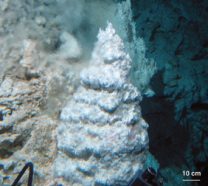Undersea vent system active for ages
Chemical analyses reveal that the tall towers of a set of hydrothermal vents called the Lost City have been growing for 30,000 years.
By Emily Sohn
Deep at the bottom of the Atlantic Ocean, there is a huge and mysterious network of rock structures called the Lost City.
Rock spires on the steep slopes of an undersea mountain stretch as high as 18-story buildings. Cracks in the rocks spit out warm fluids that are full of minerals.
 |
|
This mineral spire was formed as warm, extremely alkaline fluids spewed from the ocean floor and mixed with cold, carbonate-rich seawater.
|
| University of Washington/Woods Hole Oceanographic Institution |
Scientists have recently uncovered new clues about the chemical workings of the Lost City. The research might help explain how life began.
The search for life’s beginnings often focuses on bubbling cracks in the seafloor, called hydrothermal vents. Underwater volcanoes heat most vent systems. The Lost City is different. There, chemical reactions between seawater and rocks warm the oozing flow of mineral-rich liquids.
Researchers from Switzerland analyzed sediment from the Lost City, which lies 2,500 km east of Bermuda. They found rock deposits on the chimneys that are 25,000 years old. However, white, feathery structures around the vents formed just in the last few decades.
All together, the new data suggests that the Lost City’s vent system has been spewing warm fluids for at least 30,000 years.
Tons of tiny microbes live near the vents, happy as clams. Studying them might help explain how the world’s first microbes formed.
Finding the Lost City was only the first step. Many mysteries remain.
Going Deeper:
Perkins, Sid. 2003. Long-term ocean venting: Seafloor system has been active for ages. Science News 164(July 26):52. Available at http://www.sciencenews.org/20030726/fob3.asp .







